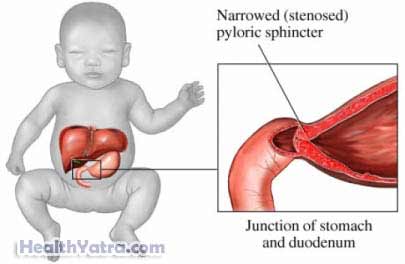تعريف
Food passes from the stomach to the small intestine. In pyloric stenosis, food cannot pass freely because the entrance between the stomach and the small intestine narrows. The narrowing is caused by the enlargement of the pylorus (the muscle at the entrance to the stomach). Almost all cases of pyloric stenosis happen in very young babies (usually 3-12 weeks old). This problem happens about 2-4 times out of every 1,000 births. It is much more common in males than in females. The sooner pyloric stenosis is treated, the fewer problems will result and the healthier your baby will be, so if you think your child has this condition, contact your doctor immediately.

أسباب
Pyloric stenosis is rarely present at birth, but develops soon afterward. Its exact cause is unknown, but it is believed to be partly inherited, as cases of pyloric stenosis tend to run in families.
عوامل الخطر
The following factors increase your baby’s chance of developing pyloric stenosis. If your child has any of these risk factors, tell your doctor.
- Prematurity
- Family history of pyloric stenosis
- More common in male babies (particularly first-born males)
- More common in Caucasian than in Latino, Asian, or African-American babies
الأعراض
Symptoms of pyloric stenosis usually begin when babies are 3-5 weeks old. They include:
- Forceful vomiting of formula or milk
- Acting hungry most of the time
- فقدان الوزن
- Signs of dehydration, such as less urination, dry mouth, and crying without tears
- التعب
- Fewer bowel movements
- Blood-tinged vomit (This happens when repeated vomiting irritates the stomach, causing mild stomach bleeding.)
التشخيص
Your doctor will ask about symptoms your child is experiencing and about his or her medical history. He or she will also perform a physical examination. An olive-shaped knot caused by the presence of pyloric stenosis is often felt by the experienced examiner. If your baby is diagnosed with pyloric stenosis, you and your family will be referred to a pediatric surgeon (a doctor specializing in surgery in children).
وقد تشمل الاختبارات التالية:
- Abdominal ultrasound —This procedure uses sound waves to make detailed computer pictures of the inside of the abdomen.
- Barium upper gastrointestinal x-ray series —A medicine (barium) is swallowed to outline the esophagus and stomach. X-ray pictures of the abdomen can then tell if food is moving normally through the stomach.
العلاج
Pyloric stenosis is treated with a surgery called a pyloroplasty, with your baby asleep under anesthesia. In a pyloroplasty, the outside of the pylorus muscle is cut to relieve the blockage. Prior to surgery, fluids and electrolytes will be given intravenously to correct the dehydration and electrolyte imbalances that are common in babies with pyloric stenosis. After the operation, fluids are given by vein until the baby can take all of his normal feedings by mouth.
الوقاية
There are no known ways of preventing pyloric stenosis, although it is possible that breastfeeding might reduce the risk.
